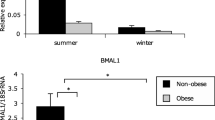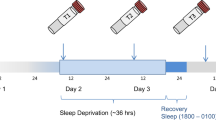Abstract
Circadian (∼24 h) rhythms in physiology and behaviour are observed in all mammals, including humans. These rhythms are generated by circadian clocks located in the hypothalamus and also in most peripheral tissues. Clock genes are essential components of circadian clocks, and mutations or polymorphisms within several of them have been associated with circadian disorders in humans. However, information about human clock gene expression has remained very limited. Peripheral blood mononuclear cells (PBMCs) represent an ideal material to investigate non-invasively the human clock at the molecular level. In the present study, we analysed the expression of three key clock genes, PER2, BMAL1 and REV-ERBα in PBMCs from ten healthy humans over a 24-h cycle. PER2 and BMAL1 were found to oscillate throughout the light–dark cycle in all subjects. Interestingly, despite normal melatonin and cortisol secretion patterns, two groups of subjects could be distinguished with significantly different mean PER2 and BMAL1 acrophases. BMAL1 oscillated with approximately the same phase as PER2, instead of being anti-phasic as anticipated from data previously obtained in other peripheral tissues. Furthermore, this unusual phase relationship of PER2 and BMAL1 in human PBMCs was associated with a constant expression of REV-ERBα, a crucial regulator of BMAL1, which is highly rhythmic in many other systems. These results reveal the existence of different chronotypes of clock gene expression patterns and suggest specific regulatory mechanisms in human PBMCs.




Similar content being viewed by others
Abbreviations
- PBMC:
-
Peripheral blood mononuclear cell
- SCN:
-
Suprachiasmatic nuclei
References
Panda S, Hogenesh JB, Kay SA (2002) Circadian rhythms from flies to humans. Nature 417:330–335
Reppert SM, Weaver DR (2002) Coordination of circadian timing in mammals. Nature 418:935–941
Preitner N, Damiola F, Lopez-Molina L, Zakany J, Duboule D, Albrecht U, Schibler U (2002) The orphan nuclear receptor REV-ERBα controls circadian transcription within the positive limb of the mammalian circadian oscillator. Cell 110:251–260
Hastings MH, Reddy AB, Maywood ES (2003) A clockwork web: circadian timing in brain and periphery, in health and disease. Nat Rev Neurosci 4:649–661
Yoo S-H, Yamazaki S, Lowrey P, Shimomura K, Ko CH, Buhr ED, Siepka SM, Hong H-K, Oh WJ, Menaker M, Takahashi JS (2004) PERIOD2::LUCIFERASE real-time reporting of circadian dynamics reveals persistent circadian oscillations in mouse peripheral tissues. Proc Natl Acad Sci U S A 102:2608–2613
Toh KL, Jones C, He Y, Eide EJ, Hinz WA, Virshup DM, Ptacek LJ, Fu Y-H (2001) An hPer2 phosphorylation site mutation in familial advanced sleep phase syndrome. Science 291:1040–1043
Ebisawa T, Uchiyama M, Kajimura N, Mishima K, Kamei Y, Katoh M, Watanabe T, Sekimoto M, Shibui K, Kim K, Kudo Y, Ozeki Y, Sugishita M, Toyoshima R, Inoue Y, Yamada N, Nagase T, Ozaki N, Ohara O, Ishida N, Okawa M, Takahashi K, Yamauchi T (2001) Association of structural polymorphism in the human period3 gene with delayed sleep phase syndrome. EMBO Rep 2:342–346
Katzenberg D, Young T, Finn L, Lin L, King DP, Takahashi JS, Mignot E (1998) A CLOCK polymorphism associated with human diurnal preference. Sleep 21:569–576
Benedetti F, Serreti A, Colombo C, Barbini B, Lorenzi C, Campori E, Smeraldi E (2003) Influence of CLOCK gene polymorphism on circadian mood fluctuation and illness recurrence in bipolar depression. Am J Med Genet 123:23–26
Takano A, Uchiyama M, Kajimura N, Mishima K, Inoue Y, Kamei Y, Kitajima T, Shibui K, Katoh M, Watanabe T, Hashimotodani Y, Nakajima T, Ozeki Y, Hori T, Yamada N, Toyoshima R, Ozaki N, Okawa M, Nagai K, Takahashi K, Isojima Y, Yamauchi T, Ebisawa T (2004) A missense variation in human casein kinase I epsilon gene that induces functional alteration and shows an inverse association with circadian rhythm sleep disorders. Neuropsychopharmacology 10:1901–1909
Bjarnason GA, Jordan RCK, Wood PA, Li Q, Lincoln DW, Sothern RB, Hrushesky WJM, Ben-David Y (2001) Circadian expression of clock genes in human oral mucosa and skin. Am J Pathol 158:1793–1801
Takata M, Buriokota N, Ohdo S, Takane H, Terazono H, Miyata M, Sako T, Suyama H, Fukuoka Y, Tomita K, Shimizu E (2002) Daily expression of mRNAs for mammalian clock genes Per2 and Clock in mouse suprachiasmatic nuclei and liver and human peripheral blood mononuclear cells. Jpn J Pharmacol 90:263–269
Boivin BD, James FO, Wu A, Cho-Park PF, Xiong H, Sun ZS (2003) Circadian clock genes oscillate in human peripheral blood mononuclear cells. Blood 102:4143–4145
Zeng B, Albrecht U, Kaasik K, Sage M, Lu W, Vaishnav S, Li Q, Sun ZS, Eichele G, Bradley A, Lee CC (2001) Nonredundant roles of the mPer1 and mPer2 genes in the mammalian circadian clock. Cell 105:683–694
Bunger MK, Wilsbacher LD, Moran SM, Clendenin C, Radcliffe LA, Hogenesch JB, Simon MC, Takahashi JS, Bradfield CA (2000) Mop3 is an essential component of the master circadian pacemaker in mammals. Cell 103:1009–1017
Filipski E, King VM, Li X-M, Granda T, Mormont M-C, Liu X-H, Claustrat B, Hastings MH, Lévi F (2002) Host circadian clock as a control point in tumor progression. J Natl Cancer Inst 94:690–697
Grechez-Cassiau A, Panda S, Lacoche S, Teboul M, Azmi S, Laudet V, Hogenesch JB, Taneja R, Delaunay F (2004) The transcriptional repressor STRA13 regulates a subset of peripheral circadian outputs. J Biol Chem 279:1141–1150
Nelson W, Tong Y, Lee JK, Halberg F (1979) Methods for cosinor rhythmometry. Chronobiologia 6:305–323
Abo T, Kawate T, Itoh K, Kumagai K (1981) Studies on the bioperiodicity of the immune response. I. Circadian rhythms of human T, B, and K cell traffic in the peripheral blood. J Immunol 126:1360–1363
Levi FA, Canon C, Touitou Y, Sulon J, Mechkouri M, Ponsart ED, Touboul JP, Vannetzel JM, Mowzowicz I, Reinberg A (1988) Circadian rhythms in circulating T lymphocyte subtypes and plasma testosterone, total and free cortisol in five healthy men. Clin Exp Immunol 71:329–335
Bourin P, Mansour I, Doinel C, Roue R, Rouger P, Levi F (1993) Circadian rhythms of circulating NK cells in healthy and human immunodeficiency virus-infected men. Chronobiol Int 10:298–305
Selmaoui B, Touitou Y (2003) Reproducibility of the circadian rhythms of serum cortisol and melatonin in healthy subjects: a study of three different 24-h cycles over six weeks. Life Sci 73:3339–3349
Haus E (1992) Chronobiology of circulation blood cells and platelets. In: Touitou Y, Haus E (eds) Biologic rhythms in clinical and laboratory medicine. Springer, Berlin Heidelberg New York, pp. 504–526
Granda TG, Liu XH, Smaaland R, Cermakian N, Filipski E, Sassone-Corsi P, Lévi F (2004) Circadian regulation of cell cycle and apoptosis proteins in mouse bone marrow and tumor. FASEB J 19:304–306
Yamamoto T, Nakahata Y, Soma H, Akashi M, Mamine T, Takumi T (2004) Transcriptional oscillation of canonical clock genes in mouse peripheral tissues. BMC Mol Biol. DOI 10.1186/1471-2199-5-18 http://www.biomedcentral.com/1471-2199/5/18:
Morse D, Cermakian N, Brancorsini S, Parvinen M, Sassone-Corsi P (2003) No circadian rhythms in testis: period1 expression is clock independent and developmentally regulated in the mouse. Mol Endocrinol 17:141–151
Leloup J-C, Goldbeter A (2003) Toward a detailed computational model for the mammalian circadian clock. Proc Natl Acad Sci U S A 100:7051–7056
Terazono H, Mutoh T, Yamaguchi S, Kobayashi M, Akiyama M, Udo R, Ohdo S, Okamura H, Shibata S (2003) Adrenergic regulation of clock gene expression in mouse liver. Proc Natl Acad Sci U S A 100:6795–6800
Acknowledgements
The authors thank Dr. A. Goldbeter for helpful discussion. This work was supported by Ministère de la Recherche (ACI 5125), Association pour la Recherche sur le Cancer (No. 3256), and Fondation pour la Recherche Médicale.
Author information
Authors and Affiliations
Corresponding author
Additional information
Michèle Teboul and Marie-Audrey Barrat-Petit contributed equally to this work
Rights and permissions
About this article
Cite this article
Teboul, M., Barrat-Petit, MA., Li, X.M. et al. Atypical patterns of circadian clock gene expression in human peripheral blood mononuclear cells. J Mol Med 83, 693–699 (2005). https://doi.org/10.1007/s00109-005-0697-6
Received:
Accepted:
Published:
Issue Date:
DOI: https://doi.org/10.1007/s00109-005-0697-6




